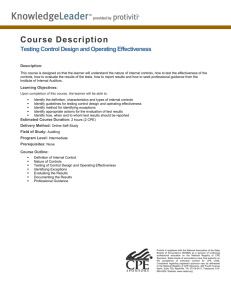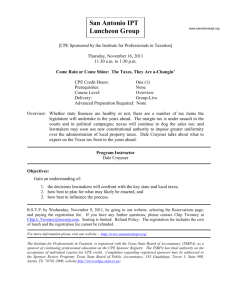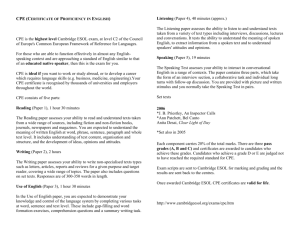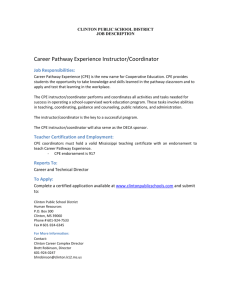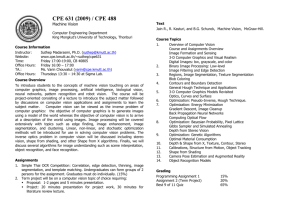Managing change within IBM: a complex supply chain
advertisement
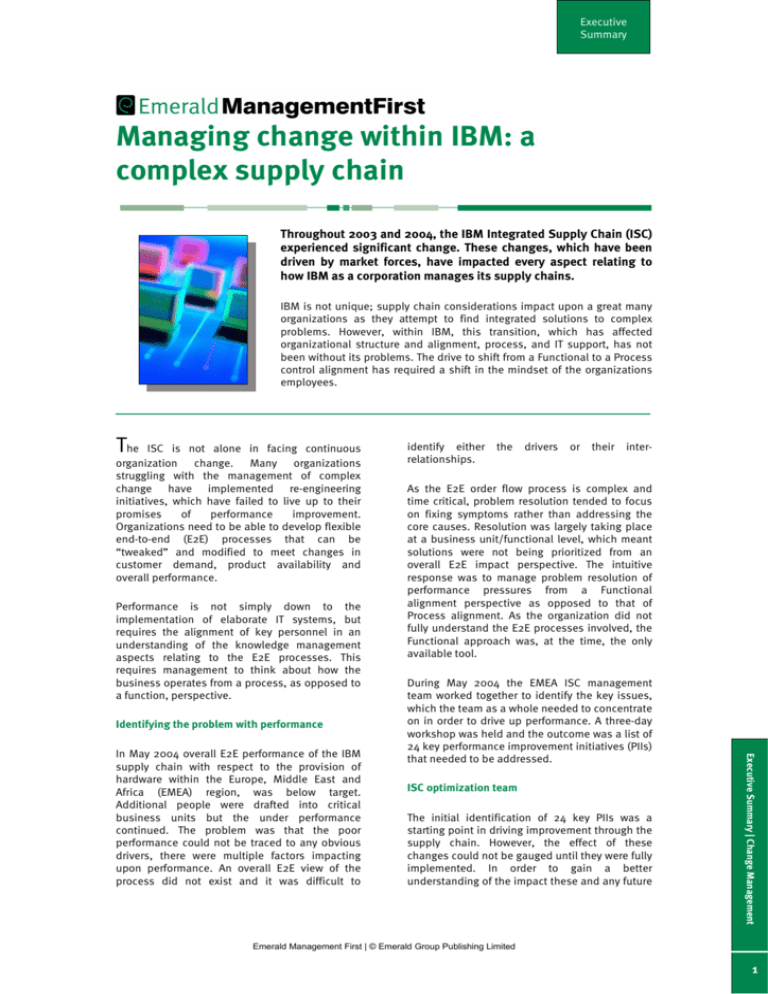
Executive Summary Managing change within IBM: a complex supply chain Throughout 2003 and 2004, the IBM Integrated Supply Chain (ISC) experienced significant change. These changes, which have been driven by market forces, have impacted every aspect relating to how IBM as a corporation manages its supply chains. IBM is not unique; supply chain considerations impact upon a great many organizations as they attempt to find integrated solutions to complex problems. However, within IBM, this transition, which has affected organizational structure and alignment, process, and IT support, has not been without its problems. The drive to shift from a Functional to a Process control alignment has required a shift in the mindset of the organizations employees. T he ISC is not alone in facing continuous organization change. Many organizations struggling with the management of complex change have implemented re-engineering initiatives, which have failed to live up to their promises of performance improvement. Organizations need to be able to develop flexible end-to-end (E2E) processes that can be “tweaked” and modified to meet changes in customer demand, product availability and overall performance. Performance is not simply down to the implementation of elaborate IT systems, but requires the alignment of key personnel in an understanding of the knowledge management aspects relating to the E2E processes. This requires management to think about how the business operates from a process, as opposed to a function, perspective. Identifying the problem with performance the drivers or their inter- As the E2E order flow process is complex and time critical, problem resolution tended to focus on fixing symptoms rather than addressing the core causes. Resolution was largely taking place at a business unit/functional level, which meant solutions were not being prioritized from an overall E2E impact perspective. The intuitive response was to manage problem resolution of performance pressures from a Functional alignment perspective as opposed to that of Process alignment. As the organization did not fully understand the E2E processes involved, the Functional approach was, at the time, the only available tool. During May 2004 the EMEA ISC management team worked together to identify the key issues, which the team as a whole needed to concentrate on in order to drive up performance. A three-day workshop was held and the outcome was a list of 24 key performance improvement initiatives (PIIs) that needed to be addressed. ISC optimization team The initial identification of 24 key PIIs was a starting point in driving improvement through the supply chain. However, the effect of these changes could not be gauged until they were fully implemented. In order to gain a better understanding of the impact these and any future Executive Summary | Change Management In May 2004 overall E2E performance of the IBM supply chain with respect to the provision of hardware within the Europe, Middle East and Africa (EMEA) region, was below target. Additional people were drafted into critical business units but the under performance continued. The problem was that the poor performance could not be traced to any obvious drivers, there were multiple factors impacting upon performance. An overall E2E view of the process did not exist and it was difficult to identify either relationships. Emerald Management First | © Emerald Group Publishing Limited 1 Executive Summary changes would have, the process to which these changes related would need to be understood. As the ISC worked through the 24 key PIIs this served to uncover or identify additional issues. If the impact was to be understood then some way of assessing, prioritizing, and managing these new PIIs would need to be implemented. To prevent the resolution of these existing and new PIIs from becoming unmanageable, not only would the process need to be mapped, but also the PIIs would need to sorted and prioritized, and their overall impact understood by a team who had E2E supply chain awareness. To satisfy this requirement a cross-functional optimization team was formed. 4. Order Ship to Order Delivery. Time taken between loading the order onto transport for delivery and actually delivering the order to the customer. E2E performance improvement The performance improvement throughout the E2E order flow process for the fourth quarter of 2004 was examined. All improvements identified as having an impact on the E2E order flow process were captured and assessed by the optimization team, and their implementation tracked and managed through the management system. Identifying issues affecting process performance The optimization team and management systems have been in effect since August 2004, but due to the time required to map the E2E process the optimization team have only been assessing change requests with respect to their impact on the process since the end of September 2004. Issues logged prior to this date were reassessed and prioritized in line with their predicted impact. In order to understand the impact and type of PII being implemented, change requests were assessed to determine the type of knowledge transfer they inferred. The PIIs were also assessed to see what type of knowledge strategy the changes support (codified or personalized). The assessment in both cases was made by the optimization team based on their understanding of the impact of each request, and methods employed in implementing them. PIIs were also assessed to see the scope of their impact across the different key stages of the order flow process. In order to be able to understand and track performance the process was divided into four key stages, or milestones. These milestones were not aligned to systems or business units but to the key stages an order goes through whilst passing through the E2E process. In the case of IBM's ISC order process the milestones are: Photo courtesy of International Business Machines Corporation Through the fourth quarter, overall E2E performance was seen to improve significantly. Across all routes to market the overall performance improvement increased by 20 per cent to 22 per cent. In effect this meant a 20-22 per cent increase in the number of customer orders processed, manufactured, and delivered to the customer within the agreed time frame. Key observations Order Receipt to Order Entry. The time taken between receiving an order and loading onto the order system. 2. Order Entry to Order Drop. Time taken between loading the order onto the order system and passing the order to manufacturing for building. 3. Order Drop to Order Ship. Time take between building the order and loading the order onto transport for delivery. Because there was a clearer understanding of the E2E processes, the optimization team were able to better understand the up and down stream impact each change would have on the process, thus allowing the senior management team to better allocate finite resources to those PIIs which would provide the best benefit. However, through this process the optimization team made a number of key observations. Executive Summary | Change Management 1. Emerald Management First | © Emerald Group Publishing Limited 2 Executive Summary Process alignment Through the formation of the optimization team an in-depth E2E understanding of the core process was developed. This allowed the team to identify and understand where change was needed and its potential impact. In effect the team was setup as a “process aligned” team. The process improvements identified provide some indication to the overall benefits a process aligned organization will have over a functionally aligned organization from an E2E process optimization perspective. People Within a complex environment made up of autonomous business units that need to work together in order to achieve a common business goal, senior management must understand the cross-functional impact of any process change requests. This is not an easy task as the volume of change requests can be significant. Therefore, a cross-functional team and supporting management system needs to be established to screen, assess, and present an impact analysis statement to senior management. This is expected to be even more significant for supply chains that extend beyond one organization's boundaries. “Within a complex environment made up of autonomous business units that need to work together in order to achieve a common business goal, senior management must understand the crossfunctional impact of any process change requests. This is not an easy task as the volume of change requests can be significant.” business but on ease of change. This “tail wagging the dog” syndrome may see important “value-add” changes being pushed down the priority ladder in favour of easy fix solutions which may in turn have little impact of performance improvement. IT and knowledge systems Codified systems should not be relied upon as the main mechanism for managing knowledge creation and distribution during times of organizational change. As the organization changes, the lead-time in IT systems deployment makes it difficult for IT systems to keep in step with the changing ways in which information is created and distributed. Personalized pro-active systems should be used as they support the tacit knowledge creation process that in turn is a key element in driving innovation and change through the organization. While this case is unique to IBM and its organizational processes the wider relevance for other businesses with this degree of functional complexity is believed to be high. It cannot be unique that timely response in changing IT systems to match different market situations is made more difficult with a functional rather than a supply chain process viewpoint. The intervention and management processes successfully developed and used in this case are recommended for other similar applications and in particular the need for personal as well as organizational learning systems is highlighted. □ July 2007. This is a shortened version of “Managing change within IBM's complex supply chain”, which originally appeared in Management Decision, Volume 44 Number 8, 2006. The authors are Stephen McLaughlin, Robert A. Paton and Douglas K. Macbeth. Without a clear E2E understanding as to how the key inter-connected processes work, process change management will be reactive and localized. Therefore, the business management of these changes will be localized and fragmented. This may lead to changes being prioritized not on their overall impact to the Executive Summary | Change Management Prioritization of change Emerald Management First | © Emerald Group Publishing Limited 3

